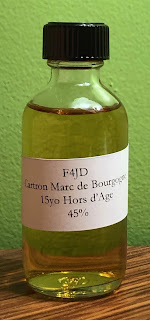As the name suggests, this is produced from 100% Borderies grapes, filled into 400 L fresh lightly toasted barrels for ten months, transferred to used casks, then blended and bottled at 40%, probably with various adjustments and chill filtration. The L13 bottling code on the neck makes me assume that this was put together in 2013, which would be consistent with how slowly specialty bottles move in Oregon.
 Cognac Park Borderies
Cognac Park BorderiesNose: classic cognac notes of grape, a little alcohol heat, gently floral, woody baking spices, honeycomb, green apple and pear, ripe berries, citrus peel, and a touch of incense. After adding a few drops of water the honey notes become stronger, the apple and pear become fresher, the oak becomes a little more tannic, but some of the complexity is suppressed amid softer aromas.
Taste: sweet with strong fruity notes of grape, berry, apple, and pear up front, soft oak beginning in the middle and carrying through to the back where it is joined by some floral notes. After dilution the fruit up front becomes stronger but less distinct and returns right at the back, the oak becomes even softer until the very back, and the floral notes are largely quashed until the finish.
Finish: caramel, floral, bittersweet grape, mild oak
This is essentially what I expected the VSOP to be. While there's nothing stunning, it has a solid level of complexity and leans into the floral notes that are a hallmark of its origins. Water shifts it in an even sweeter direction, though I find the loss of complexity to be disappointing. It does make me wonder what this spirit could have been with a higher bottling proof and a little less caramel. With a bit of a punch up I think it could hold its own against single malts in a similar price range.
In a Sidecar the nose is very floral, almost overwhelming the orange notes. The sip opens bittersweet with Seville orange and floral top notes, becoming rather creamy with some lemo around the middle, then fading out somewhat limply. The finish is rather muted with some cognac notes and a bit of orange.
Well, that was a bit disappointing. While this definitely brings floral notes to a cocktail, it doesn't fit in the way that the VSOP did. With that said, I can see this being used alongside a more rounded cognac to bring some floral character without it being all of the base spirit.





